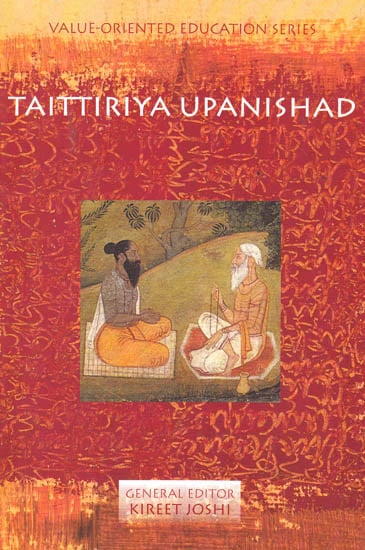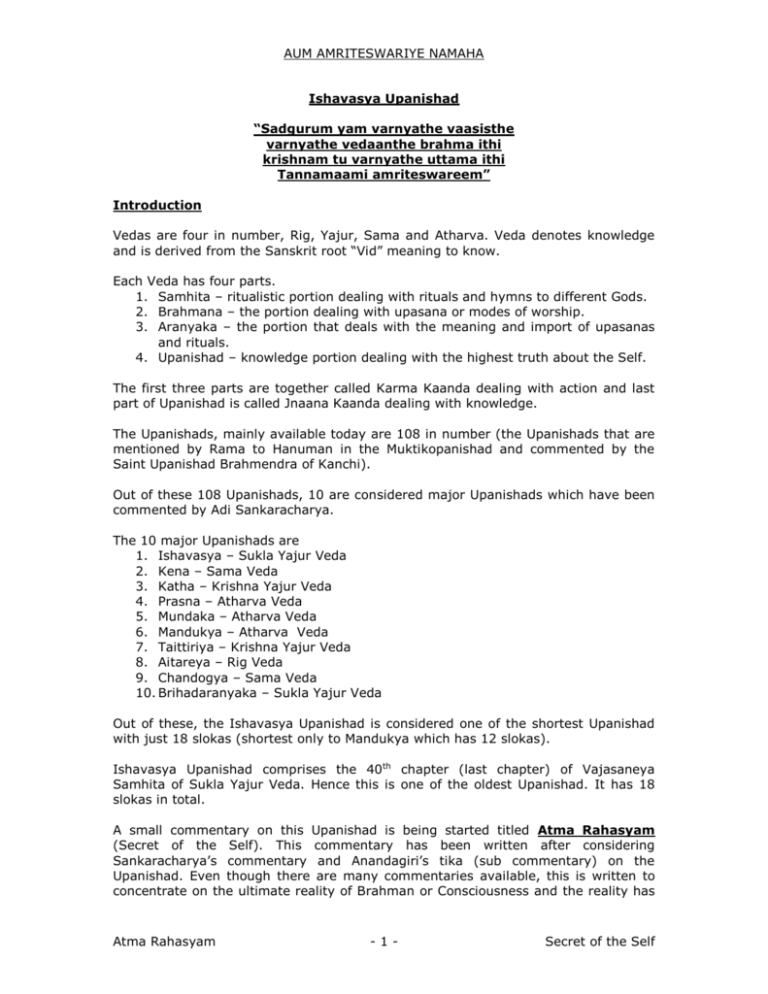

In verse 4, Kena Upanishad asserts that Brahman cannot be worshipped, because it has no attributes and is unthinkable, indescribable, eternal, all present reality. Kena Upanishad 1.3a and 1.3b, Translated by Woodburne The difference between the two versions is minor and structural - in Sama Veda manuscripts, the Kena Upanishad has four sections, while the Atharva manuscripts show no such division into sections. The Kena Upanishad is accepted as part of Sama Veda, but it is also found in manuscripts of Atharva collection. It is, for example, the ninth chapter of Talavakara Brahmana in south Indian manuscripts and as mentioned in the Bhasya (commentary) by Shankara, while the Burnell manuscript of sections of Sama Veda places it in the tenth Anuvaka of the fourth chapter (inside Jaiminia Brahmana). There are some differences in the positioning of Kena Upanishad in manuscripts discovered in different parts of India. Another odd structural feature of Kena Upanishad's poetic Khandas is verse 3, which has 8 lines (typically marked as 3a and 3b), while all other poetic verses in the first two sections are only 4 lines of mathematical metric construction. Paragraph 9 is prose and structurally out of place, which has led scholars to state that the paragraph 9 was inserted or is a corrupted version of the original manuscript in a more modern era. The first two Khandas of Kena Upanishad are poems, the last two are prose, with one exception. The third Khanda has 12 paragraphs, while the fourth khanda has the remaining 9 (3 paragraphs of main text and 6 paragraphs of the epilogue). The first Khanda has 8 verses, the second has 5 verses.

These are distributed in four khaṇḍas (खण्ड, sections or volumes). Kena Upanishad has three parts: 13 verses in the first part, 15 paragraphs in the second part, and 6 paragraphs in the epilogue. For example, the ideas in verse 2 of Kena Upanishad are found in the oldest Brihadaranyaka Upanishad's chapter 4.4, as well as the second oldest Chandogya Upanishad's chapter 8.12. Many of the ideas found in Kena Upanishads have more ancient roots. The text is likely from about the middle of 1st millennium BCE. Winternitz considers the Kena Upanishad as pre-Buddhist, pre-Jaina literature. Paul Deussen considers Kena Upanishad to be bridging a period of prose composition and fusion of poetic creativity with ideas. Ranade posits a view similar to Phillips, with slightly different ordering, placing Kena chronological composition in the third group of ancient Upanishads. Phillips dates Kena Upanishad as having been composed after Brihadaranyaka, Chandogya, Isha, Taittiriya and Aitareya (pre-6th century BCE), but before Katha, Mundaka, Prasna, Mandukya, Svetasvatara and Maitri Upanishads, as well as before the earliest Buddhist Pali and Jaina canons. All opinions rest on scanty evidence, an analysis of archaism, style and repetitions across texts, driven by assumptions about likely evolution of ideas, and on presumptions about which philosophy might have influenced which other Indian philosophies. The chronology of Kena Upanishad, like other Vedic texts, is unclear and contested by scholars. The Kena Upanishad is also significant in asserting the idea of "Spiritual Man", "Self is a wonderful being that even gods worship", "Atman (Self) exists", and "knowledge and spirituality are the goals and intense longing of all creatures". This has made it a foundational scripture to Vedanta school of Hinduism, both the theistic and monistic sub-schools after varying interpretations. It asserts that the efficient cause of all the gods, symbolically envisioned as forces of nature, is Brahman. Kena Upanishad is notable in its discussion of Brahman with attributes and without attributes, and for being a treatise on "purely conceptual knowledge". Paul Deussen suggests that the latter prose section of the main text is far more ancient than the poetic first section, and Kena Upanishad bridged the more ancient prose Upanishad era with the metric poetic era of Upanishads that followed.
#TAITTIRĪYA UPANISHAD SARVPRIYANANAD PLUS#
It has an unusual structure where the first 13 are verses composed as a metric poem, followed by 15 prose paragraphs of main text plus 6 prose paragraphs of epilogue. The Kena Upanishad was probably composed sometime around the middle of the 1st millennium BCE. It is listed as number 2 in the Muktikā, the canon of the 108 Upanishads of Hinduism.


The Kena Upanishad ( Kenopaniṣat) is a Vedic Sanskrit text classified as one of the primary or Mukhya Upanishads that is embedded inside the last section of the Talavakara Brahmanam of the Samaveda.


 0 kommentar(er)
0 kommentar(er)
